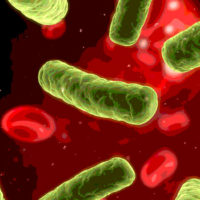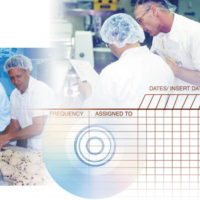In the Food Plant: Danger of Corrosion when Welding Stainless Steel

 Manufacturers and users of food processing equipment have long believed that so-called ‘stainless steel’ is indeed stainless. The fact is that most of these ‘stainless’ materials not only discolor but can corrode badly when in contact with common salts. We have all witnessed the black corrosion on cutlery after passing through a dishwasher cycle, but a dramatic example is of salt corrosion (Figure 1).
Manufacturers and users of food processing equipment have long believed that so-called ‘stainless steel’ is indeed stainless. The fact is that most of these ‘stainless’ materials not only discolor but can corrode badly when in contact with common salts. We have all witnessed the black corrosion on cutlery after passing through a dishwasher cycle, but a dramatic example is of salt corrosion (Figure 1).
Because these materials are in widespread use in food processing and preparation, it is important to recognize their limitations.
 One area of production receiving little attention is during pipe and tube fabrication where welding is widely used. Unless strict welding schedules are adhered to, not only will discoloration take place but corrosion resistance can be significantly reduced. Even very low oxygen content of protective gas can cause discoloration (Figure 2). The image on the left shows effects with 60 ppm (0.006%) oxygen, whereas the image on the right shows effects with 20 ppm (0.002%) oxygen.
One area of production receiving little attention is during pipe and tube fabrication where welding is widely used. Unless strict welding schedules are adhered to, not only will discoloration take place but corrosion resistance can be significantly reduced. Even very low oxygen content of protective gas can cause discoloration (Figure 2). The image on the left shows effects with 60 ppm (0.006%) oxygen, whereas the image on the right shows effects with 20 ppm (0.002%) oxygen.
Ron Schmidt[1] noted these potential problems, and others have also drawn attention to this issue.[2-5] While it is not too difficult to protect the outside surface of a weld by using an inert gas as coverage, preventing oxidation and loss of corrosion resistance on the inside is often overlooked. The technique of inside protection is known as ‘weld purging’ and uses inert gas to flush out air and thus oxygen before and during welding.
Weld Purging Techniques
Equipment has been developed over the past decade to make purging much easier. Currently available systems are robust, food-safe and suitable for multi-use applications. They can be supplied to cover the size range between 25 and 2400 mm in diameter.
 The most effective devices are those based on connected inflatable dams and shown in Figure 3. These are programmed to control gas flow and pressure during inflation and purging, and once placed in position, require little more input from an operator. The dams are fabricated using advanced engineering polymers and are thus suitable for use with food processing plant where elimination of contamination is essential.
The most effective devices are those based on connected inflatable dams and shown in Figure 3. These are programmed to control gas flow and pressure during inflation and purging, and once placed in position, require little more input from an operator. The dams are fabricated using advanced engineering polymers and are thus suitable for use with food processing plant where elimination of contamination is essential.
Purge gas oxygen content can be controlled using an oygen monitor. These instruments not only measure oxygen levels but will inhibit welding if the level is above that set by the operator. Recording and analysing software provides information for quality control puroses.
Conclusion
Even very low oxygen concentrations in weld gases can give rise to discoloration and corrosion. Controlling oxygen levels in purge gas can be achieved simply and efficiently using contemporary integrated purge systems.
Michael Fletcher is a qualified metallurgist with extensive experience in welding and nondestructive testing. He works as an independent consultant providing support to a wide range of manufacturing industry on a global basis.
References
1. www.food-safety.com/magazine-archive1/december-2012january-2013/food-equipment-hygienic-design-an-important-element-of-a-food-safety-program/.
2. www.food-info.net/uk/eng/docs/doc9.pdf.
3. fr.polysoude.com/images/stories/documents/english/Microbiologically_influenced_corrosion_of_stainless_steel.pdf.
4. http://cal-chem.com/wp-content/uploads/2013/07/PHARMACEUTICAL-ENGINEERING-1997.pdf.
5. www.arcmachines.com/news/case-studies/bioprocess-piping-applications.
>
Looking for a reprint of this article?
From high-res PDFs to custom plaques, order your copy today!






